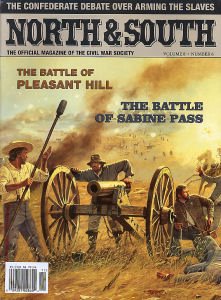NORTH & SOUTH: Still Fighting the Civil War

This morning we welcome North & South to the newsstand. It proclaims itself as "the official magazine of the Civil War Society," though I'm not sure what the Society is or does. But no matter, for North & South is a literate, very well edited presentation of interesting aspects of a cataclysmic war that has reverberated loudly through American life in the 141 years since hostilities officially ended. The magazine, which is produced in Auberry, CA in seven issues each year, consists mainly of a half-dozen fairly lengthy articles by historians, each illustrated with period prints, contemporary photos of battlefields and surviving landmarks and clearly drawn maps. I've been reading the November issue, which does a nice job with a couple of relatively obscure battles. One is the battle for the Sabine Pass, an inlet from the Gulf of Mexico that separates Texas from Louisiana. The Union forces attacked the pass from the Gulf as a way to get to Houston and then overland to the heavily defended port of Galveston, but their force of gunboats and thousands of troops was repulsed by a handful of Texas artillerymen (aided by some good shooting and a dash of Yankee ineptitude). While battles are important to North & South, the magazine also explores the politics of the Civil War. This issue carries a fascinating article about a radical idea voiced by a Tennessee general at the end of 1863. Seeing that the North could commit more soldiers to battle than the South, Major General Patrick Cleburne proposed that the Confederacy train some of its slaves as a reserve force, and that those who fought be awarded their freedom. His proposal was met with scorn by most Southern leaders, but within a year, as times got truly desperate, they were seriously entertaining similar ideas. Historian Bruce Levine examines how their thinking changed. On its face the concept of "Southern Emancipation" seems to negate the very reason why the South went to war, but in reality it was an attempt by Confederate leaders to at least maintain their independence, even if it meant the destruction of the "peculiar institution" that was a bedrock of the economy. Levine goes further, saying the Southern concept of emancipation was to hold a "free" black population in social and economic servitude, which indeed came to pass in the decades after the Civil War ended and the North abandoned Reconstruction. The issue also contains a piece about successful propaganda campaigns by each side. After the first Battle of Manassas, for example, the Northern press was full of reports of battlefield atrocities by Southerners, such as using the skulls of fallen Union soldiers as goblets and giving their womenfolk necklaces of Yankee teeth to wear. Naturally, Congress in Washington investigated the charges and declared them all true. An annual subscription to North & South (seven issues) is $39.99 from the publisher; you can get a sample copy from us for $2.59.


1 Comments:
Thanks for posting this to your blog
Post a Comment
<< Home